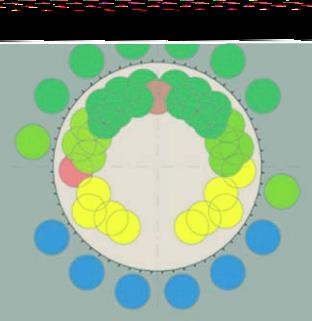Basic HTML Version




34
Geotechnical News • September 2014
www.geotechnicalnews.com
THE GROUT LINE
stability of the rock masses ahead of
and around the TBM. Drilling can
be carried out through the cutterhead
or the shield with a pattern of holes
(14 peripheral through the shield;
20 through the cutterhead) char-
acterized by different inclinations (0°,
3.5° and 7°), as illustrated in Figure 3.
Face interventions for maintenance are
planned to occur, most of the time, in
atmospheric conditions. However, in
the event maintenance will be required
during the closed mode operation, the
TBM is equipped and the personnel
are trained for hyperbaric interven-
tions.
This means that the pressure in the
excavation chamber and in the work-
ing chamber will be the same as the
face pressure.
In order to reach the excavation
chamber and perform maintenance
operations under pressure, the TBM
is equipped with a series of hyper-
baric chambers and access pipe that
connects to the excavation chamber,
which will be pressurized to the same
applied face pressure (Figure 4).
The hyperbaric system also includes
a rail transported,
portable recom-
pression chamber
(Shuttle) that
will be located in
the tunnel dur-
ing hyperbaric
activities and has
the capability
of connecting,
under treat-
ment pressure,
to the Special
Decompression
Chamber (medi-
cal lock) and
also to the TBM
manlock (pre-
chamber).
Mining Activities
The tunnel boring machine was
launched on December 27, 2011.
Based on the expected geological
conditions of the Saddle Island Lower
Plate, the plan was to mine the first
200 m of TBM tunnel in closed mode
with face support pressure less than
7 bar. For logistic reasons and due to
space limitations the conveyor belt
system which was installed after the
first 250 m in the starter tunnel; the
TBM would then operate in open
mode.
After 140 m of excavation at ring
N. 77, the air bubble pressure was
lowered and maintenance was carried
out at atmospheric conditions. At that
point, a sub-vertical fault, entering the
tunnel section from left to right, was
detected and mining resumed with
pressure exceeding 12 bar to compen-
sate the hydraulic head and guarantee
stability at the face. The TBM pro-
gressed very well into the detachment
fault and the slurry pressure in the
excavation chamber was raised to 13
bar in accordance with the groundwa-
ter head and the low cohesive material
at the face.
On July 2, 2012, at approximately 280
m of excavation along the first curve
of the alignment, the TBM penetra-
tion values became lower and lower,
until the machine stopped advancing
at push 158.
Several attempts to free the machine
were unsuccessful. The decision was
made to lower the face pressure to 0
bar to inspect the cutterhead.
In order to access the working
chamber under atmospheric pres-
sure, it is important to estimate in
Figure 2a: Open Mode Configuration.
Figure 2b: Closed Mode Configuration.
Figure 3: Drilling pattern through
the shield (outer holes) and the
cutterhead (inner holes).
Figure 4: All the environments are pressurized at the
same pressure as the face.

